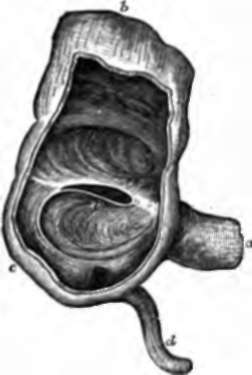62. The Large Intestine
Description
This section is from the book "Animal Physiology: The Structure And Functions Of The Human Body", by John Cleland. Also available from Amazon: Animal Physiology, the Structure and Functions of the Human Body.
62. The Large Intestine
The Large Intestine is about five or six feet long. It begins in a short cul-de-sac, the caecum (caput caecum coli), below the entrance of the ileum; and into the extremity of this there opens a small glandular structure, the vermiform appendage, which represents the enormously large intestinum caecum found in various animals, such as sheep and rabbits. At first the large intestine passes directly upwards to a point beneath the liver, and in this part of its course it is called the ascending colon ; it then passes across beneath the stomach to the left side as the transverse colon, and runs down to the region of the left groin under the name of descending colon; there it makes a loose bend, termed the sigmoid flexure, and passes into the pelvis, where it is called the rectum, or lower bowel.

Fig. 51. Ileo-colic Valve, a, cut end of the ileum; b, cut end of the colon; c, caput cecum coli; d, vermiform appendage; e, lower lip of the valve.
At the entrance of the small intestine into the great, there is an arrangement, called the ileo-colic valve, to prevent matters which have once passed into the great intestine regurgitating into the ileum. It consists of two redundant folds of the mucous membrane at the opening projecting like an upper and a lower lip into the colon, while from the angles of their junction prominences of mucous membrane, the fraena, pass round so as partially to encircle the great intestine. When the great intestine is distended, the fraena are pulled tight, and the lips of the valve brought into firm contact, the distending matters pressing their surfaces together. Thus, while there is no obstacle to the passage of matters from the ileum into the caecum, regurgitation backwards is effectually prevented, and the more distended the caecum the firmer is the closure of the valve. The efficiency of the valve is independent of muscular action, and can be exhibited perfectly on the dead subject.
63. As might be expected from the existence of the ileocolic valve, the contents of the intestine on entering the colon undergo considerable change: here they begin to acquire a faecal odour; yet additional matters continue to be absorbed from them in their passage onwards. In the colon both the longitudinal and circular muscular fibres of the walls are collected into bundles; the longitudinal fibres forming three bands, and the circular dividing the intermediate spaces into shallow recesses; and thus, although the total diameter of this part of the intestine may exceed two inches, its contents are brought well into contact with its walls as they lie in these recesses; and as they are pressed onwards from one recess to another, different portions are brought to the surface. The rectum, or lower bowel, has the muscular fibres regularly disposed around, except near the outlet, where the circular fibres form a strong sphincter, or habitually contracted ring of muscle, on which the power of retention is principally dependent, although it is assisted by striped muscles when the pressure on it is great.
Continue to:
